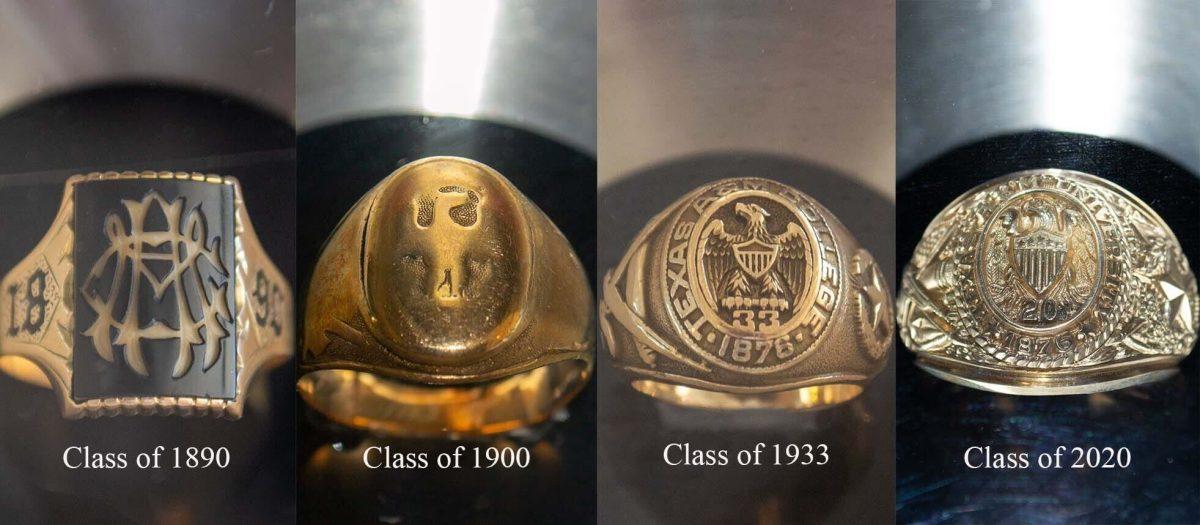Since 1889, the Aggie Ring has served as an iconic symbol of Texas A&M’s rich appreciation for the school’s traditions and values.
The Aggie Ring has been around for 133 years and has faced several challenges and multiple iterations to become the ring that Aggies around the world recognize and wear today. Currently, the ring is available in four different styles: antique, natural, Polara and white gold. Each ring also comes in both a large and small size with the standard 10K gold or the optional 14K purity. Students also have the choice of adding a diamond ranging from 10-point to 30-point for an additional cost.
In 1899, the ring that began the lineage of the modern day design was created by the Linz Brothers Jewelry Company of Dallas and was accepted by the 1899 Class Ring Committee, chaired by then-business manager of The Battalion R.J. Poulter. This design was also adopted by the classes of 1900, 1901 and 1902, and cost students $10.50 — $350.47 today. Over the next two decades, the ring would see little change except for the state seal and crossed weapon charges changing sides in 1912 before returning to their original orientation in 1926, according to the Association of Former Students’ website.
Scott Walker, Class of 1990 and vice president of the Association, said the ring hasn’t always had a strict style.
“I don’t want to say it was a free for all, but in the early days it was kind of a free for all,” Walker said. “Every class did their own thing, [and] the designs might be the same for one year, or the next day they might go in a wildly different direction.”
The ring did not begin to become officially standardized until the 1930s, Walker said.
“By the turn of the century, we started seeing elements that we would recognize today,” Walker said. “In the early 1930s to the mid-1930s is when it really started to get standardized, and it’s really only had small changes since then, the most significant one being when the college became a university and so the lettering changed.”
Walker said standardizing the design was important so Aggies from different class years could still identify each other.
“Part of the value of a class ring is that it’s recognizable,” Walker said. “If mine looks radically different from yours, then we would not have the ability to recognize each other across the airport the way Aggies do now.”
Students had a hand in finalizing the standardization in 1933, when an official senior ring committee was created by then-university President Thomas O. Walton, Walker said.
“As things are often done at Texas A&M, [President Walton] said, ‘We’re going to let the students sort this out,’” Walker said. “He appointed a committee of students and charged them with cleaning up all of the chaos, so they brought together a unified design and unified requirements to earn the ring and unified manufacturing standards.”
Walker said establishing manufacturing standards was important since the university had been cheated before by companies, placing lead in the rings rather than solid gold.
“That was part of the impetus for President Walton bringing that committee together,” Walker said. “The students were being taken advantage of by, in some cases, unscrupulous businessmen.”
In 1963, when the university began to diversify and allow women and non-Corps of Cadets members to attend, the student body decided the ring should be open to all students.
“There were a lot of other things involved in diversifying the student body and who
would be allowed certain privileges,” Walker said. “Ultimately, I think they made the right decision for all of these things, which is that an Aggie is an Aggie, and if you earn an Aggie Ring, you get an Aggie Ring.”
Kelly Hutchinson, the Association’s director of campus programs, said the antique finish of today was actually the original, and only, option available to students.
“It wasn’t until the ‘70s that the rose gold ring was offered, which is the equivalent to today’s natural finish,” Hutchinson said. “The ‘70s had some significant changes to the product offerings for the Aggie Ring.”
The rose gold ring was not the only new addition during the 1970s, Hutchinson said.
“The white gold was introduced in 1972,” Hutchinson said. “There is also another silver colored ring that is available, and that is the Polara finish, [which] is a ring that contains no precious metals and was first introduced in 1976.”
While other schools also offer class rings, the Aggie Ring still stands alone in its value to the student population, Walker said.
“For 94% of the students who earn it to actually buy it, it’s frankly unheard of, and it’s really a testament to the power of the ring and the power of the tradition and the power of the Aggie Network,” Walker said.
Hutchinson said she is glad the Association is able to continue on the Aggie Ring’s legacy.
“I am just so incredibly proud of the time and the focus that our team puts on maintaining the integrity of the ring, and part of the reason it is known worldwide is because of that Intentionality,” Hutchinson said.
History of Aggie Rings
April 6, 2022
Photo by Photos by Kyle McClenagan
The Aggie Ring has changed in appearance and substance since its creation, as seen in the above rings form the classes of 1890, 1900, 1933 and 2020.
0
Donate to The Battalion
$2065
$5000
Contributed
Our Goal
Your donation will support the student journalists of Texas A&M University - College Station. Your contribution will allow us to purchase equipment and cover our annual website hosting costs, in addition to paying freelance staffers for their work, travel costs for coverage and more!
More to Discover










